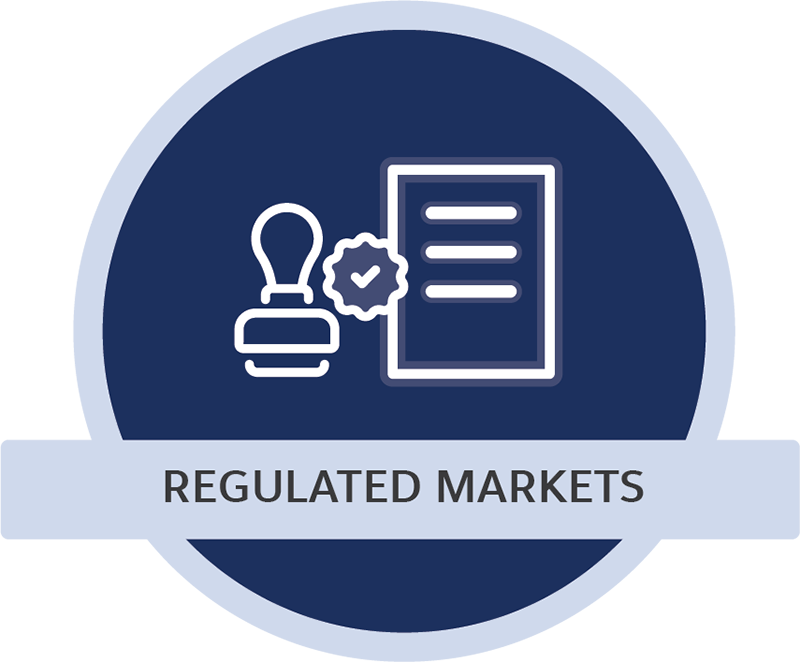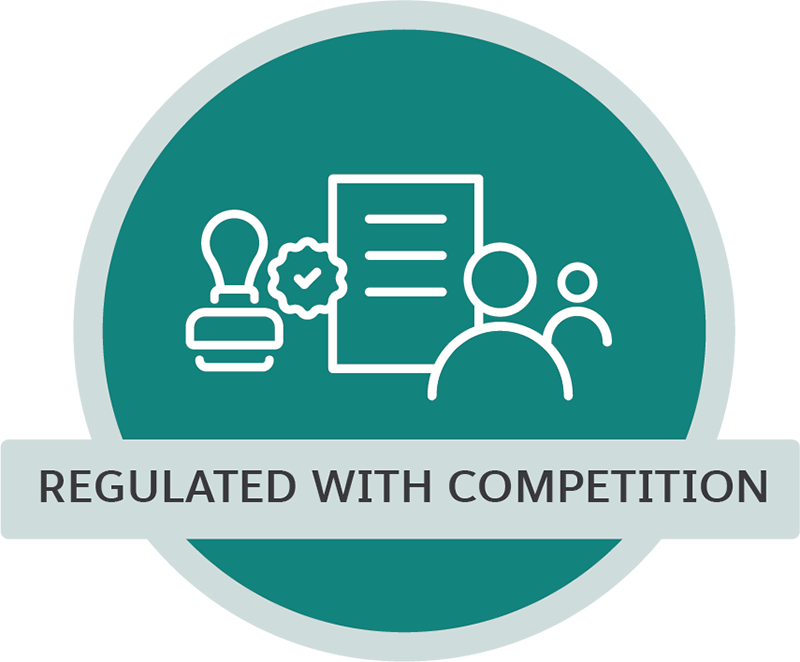Discover Market Models and Their Impact on Utilities
Learning Objectives
After completing this unit, you’ll be able to:
- Explain the different types of global utility market models.
- Identify the key challenges that utilities face today.
- Describe how changes in business processes affect key utility business units.
Types of Global Utility Market Models
Energy markets across the world are in the middle of a revolution, triggered by decarbonization and fueled by innovation. Some countries have introduced energy deregulation and competition into energy markets, which has led to the creation of new types of energy markets. Here’s a look at some of the globally recognized energy market models.
Regulated
Utility companies in regulated markets, often called vertically integrated utilities, must show a return on investment or a benefit for the money they spend.

In a regulated market, the utility companies own the infrastructure, which includes electric transmission lines and all the associated equipment, such as power poles, power lines, and transformers. These utility companies often generate or purchase electricity and sell it to customers.
Regulated with Competition
Utilities in a regulated competitive market are similar to regulated utilities, but they face some level of energy supplier competition. This type of market model often caters to the customer base with higher usage or demand.

Some regulated markets support a level of energy supplier competition. Utilities in regulated markets are often considered vertically integrated, which means they have a monopoly over the sale of power to their customers. But in many regions, utilities offer limited choices for some customer segments. Examples of such regions in the U.S. include California, Georgia, Michigan, Nevada, Oregon, and Virginia.
Sometimes residential customers buy power from the community or renewable-energy suppliers. In many cases, commercial and industrial (C&I) customers with high usage and demand buy power from energy suppliers that can meet their operational budgets and sustainability goals with clean energy.
Transitioning
Transitioning markets are open to full-scale competition.

However, these markets haven’t fully separated or unbundled all of the existing entities of the previously regulated market. Entities include generation, transmission, distribution, and retail.
Competitive
Competitive markets are also known as deregulated energy markets. In a competitive market, utility companies own and maintain the transmission infrastructure and distribute electricity, while other companies compete to supply and sell electricity and gas to customers.

In a deregulated market, vertically integrated companies are split into multiple independent companies that focus on a specific aspect of the market. For example, a single vertically integrated utility company is split into generation, transmission and distribution, and energy supply companies, though this varies between markets. Additionally, services such as meter asset management and meter ownership are sometimes split into separate companies.
Energy deregulation aims to break up monopolies and encourage supplier competition.This gives customers more options and encourages price competition. A successful deregulated market has some churn because customers mostly shop for competitive rates and offers that fit their needs and lifestyles.
Challenges Facing Utilities
The energy and utilities industries face many obstacles due to the current business environment. Consolidation is creating an increasing need to integrate, merge, and reconcile business-support systems. Here’s an overview of the industry environment and the challenges it presents.
Deregulation
Around the world, countries have introduced energy deregulation and competition into energy markets to democratize the energy and utilities industry and provide customers with choices. The more competitive a market, the more pressure on utilities to gain and retain customers.
Deregulation:
- Increases customer choice and energy supplier competition to encourage competitive energy pricing.
- Unbundles generation, transmission, distribution, supply, and customer service.
- Helps break up monopolies over the end-to-end elements of electricity, gas, and water supply.
Aging Infrastructure and Workforce
Along with competitive pressure, the energy and utilities sector is at an inflection point. Aging infrastructure needs updating, and a new generation is joining the workforce. In addition to the physical infrastructure, aging and inflexible customer information systems (CIS) and billing systems can no longer handle the data and security requirements of changing markets.
Retail Competition’s Effect on Energy Rates
Competitive markets lead to price competition, and the commercial and industrial segments benefit the most. Even customers using default services provided by utilities in competitive regions still benefit from competitive markets, because competition leads to more choices.
Climate Change and Environmental Responsibility
Climate change is a hot topic (pun partially intended). The implementation of energy savings and efficiency measures, and the use of renewable energies, are constantly increasing. That’s why utility companies must rethink their strategies and shift their operations to reach greater levels of environmental stewardship and protection. When it comes to finding new ways to generate energy through sustainable processes, it’s now or never.
Furthermore, energy sustainability measures open the door to major economic benefits. Sustainability measures can help generate mass amounts of information with valuable consumption and generation data to bring down costs.
Digital Transformation
Digital adoption and rapid technological change are forcing utilities to rethink their current business models, including how they work and the services they provide. To achieve greater sustainability and higher energy savings, utilities have to implement digitization strategies that facilitate the design, implementation, and operation of new sustainable technologies in which customers play a starring role.
Customers expect to have a more fluid and personalized experience. They want more information, including detailed data on their rates and consumption. Utilities must make their strategies customer-centric and digitize their processes and tools.
Key Business Units and Processes
The rules of the energy industry are changing as utilities embrace new technologies and customers gain more control over products.

Examine some of the impacts of changes to business processes on customers and key business units.
Accounting Rules Changes: Information Services
Often, utilities in regulated markets are unable to capitalize on the money they spend on services in the same way that they can for capital equipment. Because regulated markets lack competition, utilities haven’t prioritized information services, such as cloud-computing solutions to support their business processes. However, this is changing as some utilities acknowledge the benefits provided by software as a service (SaaS).
Utility Rules Changes: Who Creates Energy?
Now customers really do have power, their own power. With rooftop solar, electric vehicles, batteries, and microgrids, customers can sell their power back to the grid. Utilities can also pay them to reduce their consumption or use stored energy when grid capacity is strained.
Distributed energy resources are a consideration and even a concern for grid operators who fear the impact of losing customers. But, if utilities and customers are aligned, distributed energy resources can work to the advantage of both utilities and customers to:
- Regulate the flow of electricity.
- Transition to cleaner energy.
- Keep the grid safe and secure.
- Reduce energy costs.
Grid Changes: Moving to Multidirectional
Grid evolution is driving the need for cloud platforms because as the energy grid becomes more distributed and multidirectional, the enterprise platforms required to manage this flow of data and transactions must adapt.
In the past, power flowed one way, and the system was focused on safe, reliable, and affordable power. New and disruptive innovations, such as distributed energy resources, are changing this. Power now flows in two ways. Energy can be mobile, and the computing needs to manage everything are far greater. New digital energy cloud platforms, such as Salesforce, are filling that need.
Summary
In this unit, you learned about the various utility market models. You also learned about the challenges faced by utilities and the impact of industry transformation on business units and processes.
In the next unit, you learn about the common utility services and the key energy units of measure.